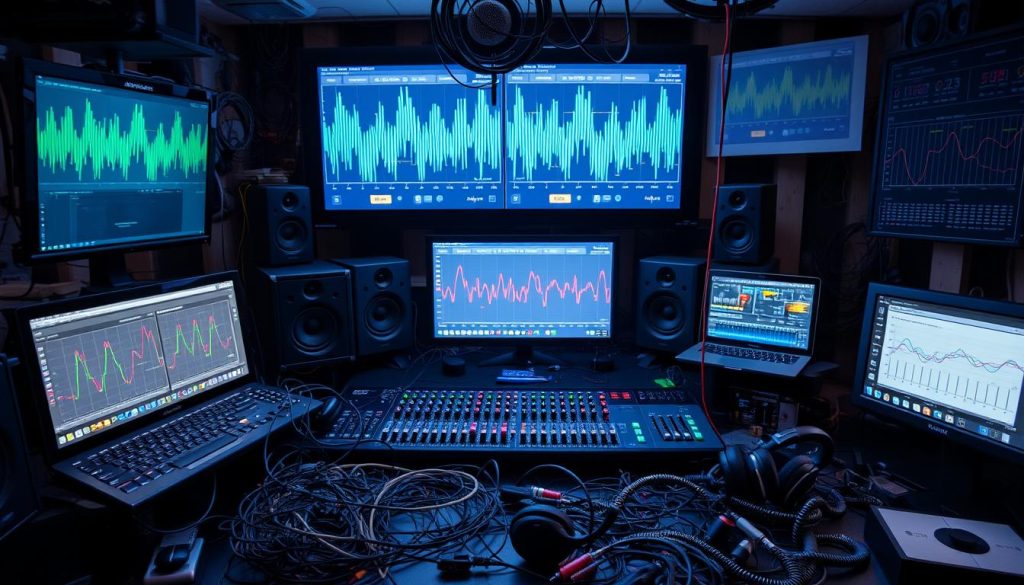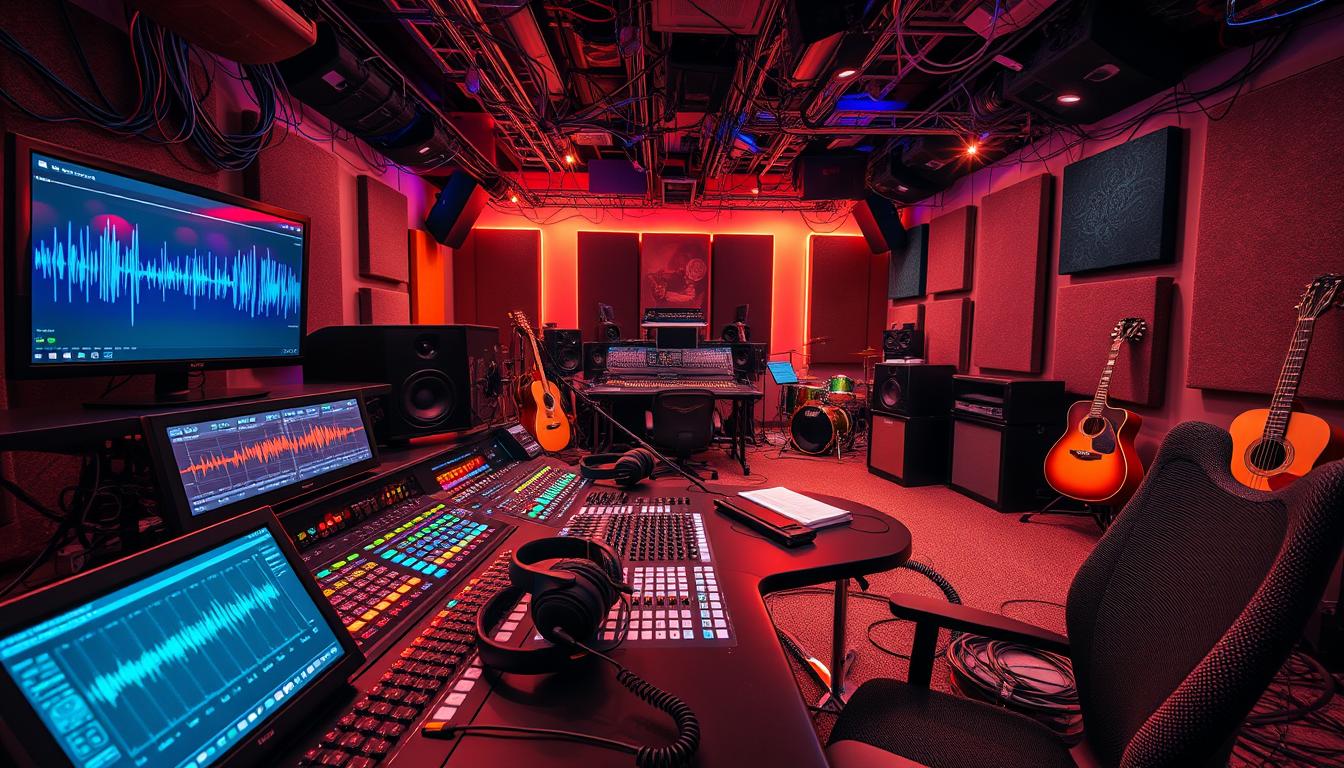As a pro audio engineer, I’ve seen many mixing mistakes. In this article, I’ll talk about the top mistakes I’ve found. I’ll give you tips to make your music sound better. Issues like too much low-end and overusing EQ can mess up your mix. By avoiding these mistakes, you can make mixes that really stand out.
Pete Doell, a top mastering engineer, is joining me. He’s worked on many hit songs. We’ll look at the top 8 mistakes in audio mixing. These tips will help both pros and hobbyists improve their skills and make better music.
Too Much Low-End Buildup
In an untreated room, low frequencies can make your mix sound muddy and unclear. This mistake often comes from bad speaker placement and poor room sound. As a pro sound engineer, I’ve found that balancing the low-end is key for a clear, professional sound.
Tame the Low-End
High-pass filters are a great way to fix too much low-end. They let you cut out the low rumble from tracks that don’t need strong bass. By using these filters, you can make your mix sound cleaner and more focused.
- Find parts of your mix with too much low-end
- Slowly raise the high-pass filter’s cutoff frequency to cut out the unwanted low sounds
- Listen closely and adjust until the low-end is tight and punchy
Think about your recording space’s sound too. Where you place your speakers and using room treatments like bass traps can help. Try different speaker spots and add acoustic panels to improve your room’s sound.
Fixing too much low-end and improving your room’s sound can make your mix sound clean and balanced. It’s a key step for a pro-quality mix.
Excessive Reverb Usage
Reverb can make a track sound deeper and more spacious. But, it’s important to use it wisely. Too much reverb can make the sound unclear and unfocused.
Many mixers use too much reverb to make their tracks sound big and immersive. But, this can hurt the clarity of the mix. Instead, I suggest using less reverb and focusing on creating rich sounds with careful arrangement and MIDI.
Achieving Depth Without Excessive Reverb
To add depth to your mix without too much reverb, try these tips:
- Play with panning and stereo placement to make your mix wider and deeper.
- Use arrangement and instrument choice to create depth, not just more reverb.
- Apply reverb to certain parts that need it, not the whole mix.
- Make sure reverb doesn’t cover up the main parts of the mix, like vocals or lead instruments.
By balancing reverb, arrangement, and MIDI, you can get a rich sound without losing clarity or focus.
| Characteristic | Excessive Reverb | Balanced Reverb |
|---|---|---|
| Sound Space | Washed-out and unfocused | Defined and cohesive |
| Sound Depth | Muddy and cluttered | Layered and dimensional |
| Mix Clarity | Compromised by reverb buildup | Clear and articulate |
| Mix Focus | Diffuse and unfocused | Centered and intentional |
audio mixing mistakes

As an audio engineer, I’ve seen many mistakes that can mess up a mix. Let’s look at some common mistakes and how to avoid them.
Mixing Too Loud
Mixing too loud is a big mistake I often see. It might seem like you’re making a big impact, but it can hurt your ears and make bad choices. Mixing at a lower volume helps you see the true balance and feel of your music.
Overcompensating with EQ
Another mistake is using EQ too much, often because of bad room sound. Trying to fix sound issues by boosting or cutting frequencies can make your music sound unnatural. Think about treating your room or mixing in a better place instead.
Excessive Limiting and Compression
Limiting and compression are useful, but too much can flatten your mix. This makes the sound tired and dull. Use these tools carefully to keep your music lively.
Lack of Automation
Not using automation can make your mix boring. Without changing volume, pan, or effects, your music stays the same. Automation adds excitement to your music.
Avoid these mistakes to make mixes that grab listeners and show off your skills.
Poor Stereo Field Utilization

As an audio engineer, I’ve learned that using the stereo field well is key. Not doing this right can make your mix sound messy and unclear. This hurts the clarity and width of your mix.
One mistake is putting too many tracks in the middle. It’s tempting to put important sounds like the kick, snare, lead vocals, and bass right in the middle. But this can make your mix sound unclear and unfocused.
Instead, try moving some of these sounds a bit to the left or right. This lets them stand out more and breathe. It makes your mix clearer and more distinct.
Analyze Professional Mixes for Inspiration
Looking at how pros mix can teach you a lot. See how they pan sounds to create depth, width, and separation. Notice how they keep the middle clear but still make a strong mix.
| Element | Panning Recommendation |
|---|---|
| Kick Drum | Center |
| Snare Drum | Center |
| Lead Vocals | Center |
| Bass Guitar | Center |
| Rhythm Guitars | Slightly Left and Right |
| Background Vocals | Left and Right |
| Keyboards | Spread Out Across the Stereo Field |
By carefully placing sounds across the stereo field, you can make your mix sound deeper, clearer, and wider. These are key traits of professional mixes. Try different panning, analyze, and improve your mixes to make them sound better.
Mixing on Colored Monitors or Headphones
As an audio engineer, it’s key to pick the right gear for mixing. Many beginners mix on headphones or monitors that change sound for the better. But, this can lead to bad mixing choices that don’t work well on other systems.
For mixing, use headphones or studio monitors with a flat sound. This way, you hear your mix as it really is, not skewed. You want your mix to sound good on many devices, not just your own.
The Importance of Flat Frequency Response
Headphones and studio monitors with a flat sound give you a true, uncolored mix. This helps you spot issues with the low, mid, or high sounds. You can then fix these to make your mix sound balanced and professional.
- Flat frequency response gives you an accurate mix.
- Colored gear can lead to bad mixing choices.
- Invest in high-quality studio monitors or headphones with a flat frequency response for best audio monitoring.
The secret to a great mix is honest, unbiased sound. Use headphones or studio monitors with a flat frequency response. This helps you make better choices and produce mixes that sound good everywhere.
Phase and Polarity Issues
As an audio engineer, I’ve found that phase shifts and polarity issues can be tough. They can make a mix sound weak and unclear. This often happens when recording drums with many microphones.
Before finalizing a drum sound, check the phase between tracks. Flip the polarity on tracks with phase problems. Keeping tracks in phase is key for a strong mix. If you ignore this, your mix might sound dull, even with lots of EQ or compression.
Managing phase and polarity well helps me get clear, strong drum sounds. This step is simple but important. It greatly improves the final sound. If your mix sounds unclear, watch the phase relationships closely.

